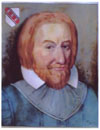.gif)
.gif)
Edward Maria Wingfield
 |
|
Edward Maria Wingfield |
Edward-Maria Wingfield was the only member of the Virginia Company’s leaders to go to Jamestown to oversee his investment and became the colony’s first president. Wingfield came from wealthy stock in England and served in the military in Holland and Ireland. His time in Virginia was rife with controversy; the other colonists, unhappy with the way Wingfield ran the colony, eventually removed Wingfield from office and had him jailed. He stayed in the colony less than a year and returned to England where he died sometime after 1619.
Edward-Maria Wingfield was born in 1550 in Stonley Priory, a house about a hundred miles north of London. His father Thomas-Maria Wingfield received the added name “Maria” from his godmother, Queen Mary of France (who was Henry VIII’s sister), and passed it on to his son. Edward attended a school for barristers in 1576 but he left his studies uncompleted after three years to fight against the Spanish in Holland. He also saw military service in Ireland before his involvement with the Virginia Company.1
Wingfield became one of the chief financial contributors to the Virginia Company along with Rev. Richard Hakluyt (the younger), George Popham, Thomas Gates, George Somers, Thomas Hanham, Raliegh Gilbert, and William Parker. When the company was in financial trouble, Wingfield mortgaged his estate to make the venture possible. Edward-Maria Wingfield was the only one of the senior members to risk his life in the New World, which made him the logical choice for the first president. However, Wingfield’s presidency was short-lived and unhappy due to many factors, some of his own making and some due to the nature of placing a colony in the middle of such a wild and unfamiliar land.
Controversy began on the voyage across the ocean when Captain Christopher Newport erected gallows on Nevis (one of the Leeward Islands in the British West Indies) to hang John Smith, an act which Wingfield supported. Wingfield also deserves credit (or blame) for choosing the location of the colony. He selected a site for its defensibility but he did not take into account the water supply or livability of the area. Wingfield oversaw the building of James Fort and the planting of the first crops. Since the group of 104 colonists and fifty-six sailors arrived in spring, it would be quite some time before the crops were ready for harvest. As a result, food supply quickly became a problem. Wingfield, as president of the colony, was charged with keeping the colony alive until harvest. He decided to impose military-style control and rationing of food that was especially unpopular with the colonists.
The rationing of food led to accusations of abuse and favoritism that Wingfield denied. The problem festered until a majority vote of the council removed Wingfield from office. The council also tried Wingfield and jailed him for a short time. John Martin accused him of "doing slack in the service of the colony, and do nothing but tend his pot, spit and oven, [saying] 'But he hath starved my son and denied him a spoonful of beer. I have friends in England [that] shall be revenged on him if he ever come to London.'"2 The council also accused Wingfield of being an atheist for not having a Bible in his possession a charge he denied saying that his was lost or stolen in England prior to his sailing to Virginia. His removal prompted him to make the journey back to England and return to the Kimbolton School where he served as Chief Feofee (i.e., Chairman of the Board of Governors) until his death.
Edward-Maria Wingfield was an enigmatic figure who deserves credit for getting the colony up and running; however, he deserves a fair amount of the blame for the mismanagement that led to food shortages and the deaths of many colonists. Wingfield was no coward; he actively participated in military action against the natives, taking an arrow through the beard. In fact, his military background and style created the rift with the people of the colony. He risked his life at the age of fifty-six to make the voyage to Jamestown while the rest of his peers waited in London to watch their investment from afar.
For Further Reading
Bridenbaugh, Carl. Jamestown, 1544-1699. New York: Oxford University Press, 1980. Bridenbaugh's 1980 classic is the most widely circulated book on the Jamestown experience.
Haile, Edward Wright. Jamestown Narratives: Eyewitness Accounts of the Virginia Colony. Champlain, Virginia: RoundHouse, 1998. This collection of primary sources provides an excellent look into the workings of the first English colony in North America to survive.
Wingfield, Jocelyn R. Virginia's True Founder: Edward Maria Wingfield and His Times 1550-c.1614: The First Biography of the First President of the First Successful English Colony in the New World. Athens, Georgia: Wingfield Family Society, 1993. This biography was produced by one of Wingfield's descendants.
|
©Crandall Shifflett |